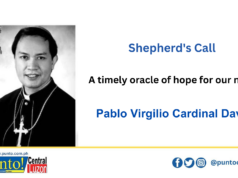TODAY WE celebrate what I call our “Christmas Part Two,” the Feast of Epiphany. It is inspired by the Christmas story as narrated to us by St. Matthew. It used to be set on a specific date—January 6 – which is still the case for the Eastern Christian tradition. The Roman Catholic Church has fixed it instead to the first Sunday of the calendar year, not to a specific date.
Last December 25 we celebrated what I call our “Christmas Part One”, which is inspired by the Christmas story as narrated to us by St. Luke. You see, we have two Christmas stories in the Bible: one by St. Luke and the other by St. Matthew. Each one is told in a very unique way and each also with a very unique purpose—which is the case with storytelling.
Unfortunately, maybe because of our tendency to be eclectic in our religious orientation as Filipinos, we have tended to mix up the two. I wonder if it is an influence of our HALO-HALO culture. We mix up all sort of sweet desserts, blend them with ice and milk and the result is indeed delicious and refreshing. But there is still a rule about what we mix into our halo-halo! There are certain things that just won’t blend with it, even if they are also delicious by themselves. You don’t put ketchup, or bagoong (shrimp paste), or toyo in your halo-halo, do you? Otherwise, you spoil it.
The portrayal of a homeless holy family looking for a place to stay, the Son of God born on one silent night in a stable for animals, wrapped in swaddling clothes and lying in a manger, with lowly shepherds as his first visitors guided by a host of angels singing the Gloria—all of that is from St. Luke, what I just called Christmas Part One. It is what we dramatize on December 25 as PANUNULUYAN.
St. Matthew tells the story differently. Instead of Mary and Joseph traveling from Nazareth and looking for a place in Bethlehem for the birthing of the baby Jesus, you have the holy family living in a regular house (not a stable) in Bethlehem. You don’t have Luke’s shepherds being guided by angels singing Gloria; what you have in Matthew is a star guiding the magi who travel from far away. The setting is not a silent night but a horrible night because there is an insecure king Herod in the background, who also wants to find the child, not to worship but to kill him, to keep himself in power.
This is how Matthew tells his Christmas story and we miss the whole point when we make our Christmas Bethlehem scenes into a mish-mash of everything: the angels and the star, the shepherds and the magi, it is all like HALO-HALO with ketchup and bagoong. How can you appreciate that?
We all love story-telling, of course. But to enjoy a good story, or to be able to tell a good story, you have to follow some rules too. Otherwise, we can get lost in the details and miss the point. In Tagalog, we might say, siguraduhing may SAYSAY ang SALAYSAY. I have mentioned many times before that for us Filipinos, history is not just a narration of facts. More importantly, it is about the meaning or the significance of the facts. What Fr. Willy Samson, the Jesuit storyteller calls, “KUWENTONG MAY KUWENTA” (stories with sense, moral, or relevance).
In both stories, the point of Christmas is basically the good news about the God whose coming among us brings PEACE. St. Luke’s Christmas Story tells us God brings peace on earth through people of good will. His people of good will are mainly the poor, represented by lowly shepherds, the ones who make space for the Son of God who is destined to be the Good Shepherd because he will give up his life as a sacrificial lamb forthe redemption of the world.
In St. Matthew, the people of good will are not the Herods who kill, not the tyrants who are motivated only by power and self-interest. They are rather the ones who, in all humility, look up to heaven and allow themselves to be guided by a star. They are motivated by wisdom, not by power. They are willing to make the long journey to meet in each other the EMMANUEL, THE GOD-WITH-US, no matter what color, language, nation or race they belong to. What draws them together is the common desire to offer their gifts: gold for servant leadership, frankincense for sincere worship, and myrrh for prophetic courage.
Their gifts are but tokens for the gift of all gifts: the Prince of Peace, the one who teaches us how to be instruments of peace—so that, where there is hatred we learn to bring love, where there is injury, pardon, where there is doubt, faith, where there is despair, hope. Where there is darkness, light; where there is sadness, joy.
It is this Prince of Peace who guides us even as we walk in the valleys of death like the Covid pandemic. It is he who teaches us the true principles for our survival: that “It is in giving that we receive, in pardoning that we are pardoned, and in dying that we are born to eternal life.”
(Homily for the Feast of the Epiphany, 3 January 2021, Mt 2:1-12)





